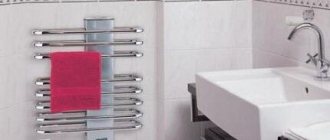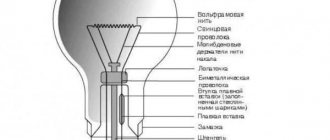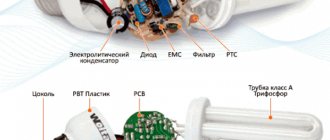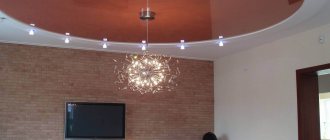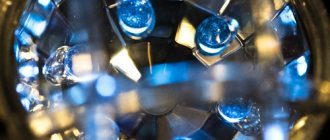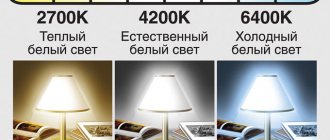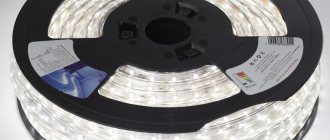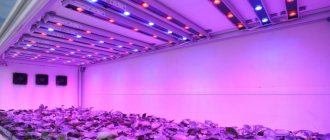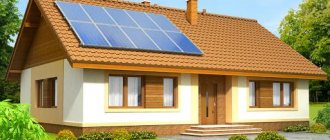The main factor in the development of any plant is a sufficient level of light. Lighting is necessary for photosynthesis (that is, nutrition and increase in green mass) and photomorphogenesis (growth of seeds, roots, fruits). These processes require light with different characteristics.
In nature, sunlight contains all the necessary rays, and the plant gets what it needs. In home and industrial conditions (for example, for greenhouses), illumination must be maintained artificially. To create an optimal light flux, it is recommended to use special phytolamps.
Contents
Phytolamps
The summer season begins at the beginning of spring. Gradually, the soil and air warm up, and gardeners prepare the seedlings for planting in natural sunlight. However, many lovers of fresh greens, which they eat all year round, and city farmers know that it is not necessary to wait until spring and summer to plant plants.
- Why do you need additional lighting for seedlings?
- What is a phytolamp
- Pros of phytolamps
- Types and forms of phytolamps Sodium gas-discharge lamps (DNAT)
- Metal halide (MGL)
- Mercury gas-discharge phytolamp (DRLF)
- Fluorescent lamps
- LED phytolamps
- What are lenses for?
Why do you need additional lighting for seedlings?
Thanks to artificial light sources, it is possible to grow seedlings in the complete absence or insufficient lighting. Electric lighting devices have a different set of spectra aimed at activating physiological processes in plants.
With their help, photosynthesis reactions are launched and new compounds are formed. Thanks to them, seeds quickly germinate into sprouts and adult plants, which after a short period of time produce excellent harvests.
What is a phytolamp
A phytolamp is an electrical source of electromagnetic radiation, specially designed for growing plants. The spectra of phytolamps are already built into the modular design of a specific model or can be independently adjusted for different crops and growth stages.
Through phytolights, the processes of photosynthesis that occur in plant chloroplasts are activated.
The growth and development of greenery depends on their speed. Therefore, you need to approach the choice of phytolamp thoroughly. Growing plants requires a special spectrum, light output and color temperature of the light source.
Phytolamps or agrolamps are much more economical than conventional light bulbs, taking into account the luminous flux output . They are intended for plants. As they are used, active growth of seedlings is observed, susceptibility to the environment and stress is reduced, flowering is stimulated and productivity increases
Pros of phytolamps
- Lighting is aimed at the crops, and not throughout the room;
- You can use phytolights in rooms with normal lighting;
- Plants grow faster, bloom and bear fruit, remaining healthy and strong;
- Phytolamps allow you to grow various crops all year round;
- Agropanels consume little electricity compared to incandescent lamps;
- Innovative phytolamps are equipped with technology for removing excess heat.
The disadvantages include the fact that the light of some types of phytolamps is harmful to humans and therefore it must be installed in a non-residential area. Additionally, fixtures take up space and must be mounted correctly to achieve the desired effect.
Lamp color temperature
Color temperature is measured in Kelvin (K).
2700K – “warm” light / Warm light – radiation predominates in the red part of the spectrum, incandescent lamp light. Other types of lamps produce a glow close to that of an incandescent lamp. This type of glow is used for flowering.
4100K – “neutral white” light / Cool light – radiation across the entire spectrum, with a predominance in the green part.
6400K – “daylight or cool white” light / Day light – radiation predominates in the blue part of the spectrum, which is suitable for vegetative growth.
8000–25000K – ultraviolet / Black light – ultraviolet radiation.
.
.
Types and forms of phytolamps
According to the complexity of use, spectra and emitted light, phytolights are divided into the following lamps:
Sodium gas discharge lamps (HSD)
They are used in greenhouses for growing seedlings and garden crops, most often to extend daylight hours (additional light). Such phytolamps are not suitable for growing plants at home. They are too powerful and heat up quickly.
Such phytolamps are divided into basic ones, when the light is distributed throughout the entire room and with a mirror coating. In this case, lighting has a directed effect on the crops themselves. The lamps emit yellow-green and orange light, but the spectrum differs significantly from the natural one and is poorly transmitted. They need special lamps. They work for a long time under any climatic conditions, but quickly lose their luminosity; in addition, problems arise with their disposal, since they contain mercury vapor.
Metal halide (MGL)
They are a type of gas discharge lamps. There are halogen vapors in the MGL flask. Phytolamps of this type require durable lamps. Metal halide lamps can operate continuously for up to two years, but require a stable voltage, are explosive and also quickly lose their luminosity.
They are more expensive due to the fact that they have high light output and different lighting spectra for different crops.
Mercury gas-discharge phytolamp (DRLF)
Suitable for any lamp. Thanks to mirror coating, the lamp directs light to a specific location. DRLFs are durable in use, provide bright light, but distort colors. In addition, such lamps require constant voltage without interruption.
Fluorescent lamps
- This is a type of gas-discharge phytolamps, but for growing plants, those that have the desired luminescence spectrum are selected. Usually used in everyday life, they are economical, cheap and safe. However, they cannot work in rooms with temperatures below +5°C. In addition, fluorescent lamps have a low degree of luminescence and are not suitable for commercial and industrial use.
LED phytolamps
can be assembled into different lighting systems, they are available and have different emission spectra. They are not demanding on voltage and can operate at full power immediately after switching on. LEDs consume little electricity, are very durable, they can be used to select any spectrum of light for various crops and tasks, and they lose efficiency very slowly. However, they should not be allowed to overheat significantly.
Fluorescent lamps for seedlings
Fluorescent lamps can be linear, compact, energy-saving .
Linear lamps are long tubes that are conveniently placed in a row above a rack.
Energy-saving ones provide much more light per unit of lamp power. For example, you can choose a 54 W energy-saving lamp that produces as much as 5000 Lux. Compact fluorescent lamps differ in their size and shape. Their convenience is that many lamps of this type have a standard screw-in base and are already equipped with a built-in starter. They are all produced in the same three color temperature ranges: red - up to 2700 K, daylight - up to 5000 K and cold - up to 6500 K.
Compact lamps have appeared relatively recently. Most linear models are outdated. Therefore, it is better to give preference to the first.
Fluorescent lamps differ in emission temperature on the Kelvin scale, which can vary from 2700 to 7800 K, and light intensity in lumens.
Specifications
Luminescent elements require special lamps equipped with ballast (ballast) and a reflector (reflector), which allows the light not to be scattered, but concentrated on the surface for illumination.
The simplest electromagnetic ballast equipment (ballast) is an electromagnetic choke for fluorescent lamps with a starter. But it is better to use electronic ballast, which gives an even glow without blinking when turned on or flickering when the lamp is operating. Some electronic ballasts have a function for dimming the lamps. In particular, such regulation can be carried out from a light sensor.
The cost of ballasts varies greatly:
- throttle – 200 rub.;
- electronic ballasts - from 900 rubles;
- electronic ballasts with the ability to regulate, but without a control device included - from 2000 rubles.
Regulating devices are not included in the kit, as they vary greatly in type and price, and can also be used simultaneously on many lamps.
How to choose ESL biolamps
Please also pay attention to the following technical characteristics of the light bulbs:
- Basement. Most often, linear phytolamps are produced with a G13 base. Compact fluorescent lamps can have base types E27 and E40.
- Power of energy-saving lamps (ESL). Elements for illuminating plants are available in several standard powers - 15 W, 18 W, 30 W, 36 W, 58 W. The relationship between the power of the lamp and the amount of light it produces is not direct. The longer and more powerful the lamp, the more light it gives. Two 15 W lamps will give a total of less light than one 30 W fluorescent lamp.
- Supply voltage. Most manufacturers adhere to the standard for an electrical network of 220 W, 50 Hz.
- Dimensions. They are important when installing fluorescent lamps in the aquarium lid or when planning illuminated shelves.
- Lifetime. Most often, manufacturers talk about the service life of fluorescent lamps at 10,000 hours. According to technical documentation, Osram Flora lamps should shine for 13,000 hours. But practice shows that most lamps fail after 7500 hours of operation. The reason for such rapid resource depletion is simple overheating.
Reflectors for fluorescent lamps must have holes for ventilation. If many high-power lamps are installed, an additional fan is installed to cool them. Small PC fans can be used.
Popular manufacturers and prices
Comparative table of linear phytolamps from various manufacturers
| Model of a linear fluorescent phytolamp | Length, mm | Illumination, lm | Base | price, rub. |
| Osram Fluora L 36W/77 | 1200 | 1400 | G13 | 360 |
| Philips TLD 36W/89 | 1200 | 2450 | G13 | 510 |
| Sylvania F36W/GRO | 1200 | 930 | G13 | 215 |
| Narva LT 36W/077 Lumoflor | 1200 | 1600 | G13 | 230 |
Osram Fluora lamps of various wattages
Professionals often use combined lighting of two types of lamps - warm red and cool blue spectrum. This approach allows you to optimally meet the lighting needs of cultivated plants.
How to choose a phytolamp for plants
There are many types of lamps and each has its own advantages and disadvantages. What should you pay attention to when choosing a phytolamp for plants? To choose the appropriate option, you need to decide on the purpose of purchase and the place where the phytolamp will be installed in the future.
If you need a phytolamp for growing plants on a windowsill, then there are many types to suit every taste and budget. A more difficult task is to find a phytolamp for seedlings and plants grown in greenhouses or specialized premises at the production level. It is worth considering how long the phytolamp will work, continuously or seasonally, and how often it requires maintenance and replacement during operation. Before buying a phytolamp, it is worth checking how demanding it is in terms of voltage, what spectrum of radiation it produces, what power it has, what material it is made from, the illumination area and the luminous flux power (PPFD) at different heights from the surface of the lamp to the plant.
It is also necessary to correctly calculate, based on the area of the room and the crops that the city farmer is going to grow, the required number of phytolamps, their power and spectrum. Many of them emit a lot of heat, so it’s worth choosing models that are equipped with cooling radiators and technologies for removing excess heat.
For the growth and development of various plants, they need blue, red light at different wavelengths, infrared radiation, and sometimes ultraviolet. Therefore, you need to understand this before purchasing phytolamps. An important factor is the ease of assembly and dismantling of the lamps.
Phytolamps come in round, square and linear shapes. The choice should be made on the lamp that, in terms of power and area, will optimally illuminate the plants. Round, square or spotlights are suitable for illuminating a free-standing plant.
The advantages of such phytolamps are high power, compactness, the ability to combine spectra and ease of use. 36 W agricultural lights illuminate plants that are grown at home. Phytolamps with a power of 100 W or more are used in greenhouses. To grow plants in long containers in one row, linear phytolamps are used. However, for a safe but effective glow, it is necessary to calculate the optimal height for installing the lamps. It is also worth considering the area of radiators and illumination.
Plant lighting with white LEDs
The intensity of photosynthesis under red light is maximum, but under red light alone, plants die or their development is disrupted. For example, Korean researchers [1] showed that when illuminated with pure red, the mass of grown lettuce is greater than when illuminated with a combination of red and blue, but the leaves contain significantly less chlorophyll, polyphenols and antioxidants. And the Faculty of Biology of Moscow State University [2] found that in the leaves of Chinese cabbage under narrow-band red and blue light (compared to illumination with a sodium lamp), the synthesis of sugars is reduced, growth is inhibited and flowering does not occur.
Rice. 1
Leanna Garfield,
Tech Insider - Aerofarms
What kind of lighting do you need to get a fully developed, large, fragrant and tasty plant with moderate energy consumption? How to evaluate the energy efficiency of a lamp?
Basic metrics for assessing the energy efficiency of phytolight:
- Photosynthetic Photon Flux
(
PPF
), in micromoles per joule, i.e., the number of light quanta in the range of 400–700 nm emitted by a lamp that consumed 1 J of electricity. - Yield Photon Flux
(
YPF
), in effective micromoles per joule, i.e., in the number of quanta per 1 J of electricity, taking into account the multiplier - the
McCree
.
PPF
always turns out to be slightly higher than
YPF
McCree
curve is normalized to one and is less than one in most of the range), so the first metric is beneficial for lighting sellers to use. The second metric is more profitable to use for buyers, since it more adequately assesses energy efficiency.
Efficiency of DNAT
Large agricultural enterprises with extensive experience and counting money still use sodium lamps. Yes, they willingly agree to hang the LED lights provided to them over the experimental beds, but they do not agree to pay for them.
From Fig. 2 shows that the efficiency of a sodium lamp is highly dependent on power and reaches a maximum at 600 W. Typical optimistic YPF
for a sodium lamp 600–1000 W is 1.5 eff. µmol/J. Sodium lamps 70–150 W are one and a half times less efficient.
Rice.
2. Typical spectrum of a sodium lamp for plants
(left)
.
Efficiency in lumens per watt and effective micromoles of commercial Cavita
,
E-Papillon
, Galad and Reflex
(right)
Any LED luminaire with an efficiency of 1.5 eff. µmol/W and reasonable price, can be considered a worthy replacement for a sodium lamp.
The questionable effectiveness of red-blue phytolights
In this article we do not present the absorption spectra of chlorophyll because it is incorrect to refer to them in a discussion of the use of light flux by a living plant. Chlorophyll in vitro
, isolated and purified, only really absorbs red and blue light.
In a living cell, pigments absorb light in the entire range of 400–700 nm and transfer its energy to chlorophyll. The energy efficiency of light in a leaf is determined by the McCree 1972
(Fig. 3).
Rice. 3. V
(λ) - visibility curve for humans;
RQE
—relative quantum efficiency for the plant (
McCree
1972);
σ r
and
σ fr
are absorption curves of red and far-red light by phytochrome;
B
(λ) - phototropic efficiency of blue light [3]
Note: the maximum efficiency in the red range is one and a half times higher than the minimum efficiency in the green range. And if you average the efficiency over a somewhat wide band, the difference becomes even less noticeable. In practice, the redistribution of part of the energy from the red range to the green range sometimes, on the contrary, enhances the energy function of light. Green light passes through the thickness of the leaves to the lower tiers, the effective leaf area of the plant increases sharply, and the yield of, for example, lettuce increases [2].
Plant lighting with white LEDs
The energy feasibility of lighting plants with common white-light LED lamps was studied in [3].
The characteristic shape of the spectrum of a white LED is determined by:
- the balance of short and long waves, correlating with color temperature (Fig. 4, left);
- the degree of spectral occupancy, which correlates with color rendering (Fig. 4, right).
Rice.
4. Spectra of white LED light with the same color rendering, but different color temperature CCT
(left)
and with the same color temperature and different color rendering
R a (right)
The differences in the spectrum of white diodes with the same color rendering and the same color temperature are subtle. Consequently, we can evaluate spectrum-dependent parameters only by color temperature, color rendering and luminous efficiency - parameters that are written on the label of a conventional white light lamp.
The results of the analysis of the spectra of serial white LEDs are as follows:
1. In the spectrum of all white LEDs, even with a low color temperature and maximum color rendering, like sodium lamps, there is very little far-red (Fig. 5).
Rice.
5. Spectrum of white LED (
LED
4000
K R a
= 90) and sodium light (
HPS
) in comparison with the spectral functions of plant susceptibility to blue (
B
), red (
A_r
) and far-red light (
A_fr
)
Under natural conditions, a plant shaded by a canopy of alien foliage receives more distant red than near red, which in light-loving plants triggers the “shade avoidance syndrome” - the plant stretches upward. Tomatoes, for example, at the growth stage (not seedlings!) need far red to stretch, increase growth and the total occupied area, and therefore the harvest in the future.
Accordingly, under white LEDs and under sodium light the plant feels like it is under the open sun and does not stretch upward.
2. Blue light is needed for the “sun tracking” reaction (Fig. 6).
Rice.
6. Phototropism - turning leaves and flowers, stretching stems towards the blue component of white light (illustration from Wikipedia)
One watt of white LED light contains twice as much phytoactive blue component as one watt of sodium light. Moreover, the proportion of phytoactive blue in white light increases in proportion to the color temperature. If, for example, you need to turn decorative flowers towards people, they should be illuminated from this side with intense cold light, and the plants will turn around.
3. The energy value of light is determined by color temperature and color rendering and can be determined with an accuracy of 5% using the formula:
where is the luminous efficiency in lm/W, is the general color rendering index, is the correlated color temperature in Kelvin.
Examples of using this formula:
A. Let us estimate for the basic values of the parameters of white light what the illumination should be in order to provide, for example, 300 eff. for a given color rendering and color temperature. µmol/s/m2:
It can be seen that the use of warm white light with high color rendering allows the use of slightly lower illumination levels. But if we take into account that the luminous efficiency of warm light LEDs with high color rendering is somewhat lower, it becomes clear that by choosing color temperature and color rendering there is no energetically significant win or loss. You can only adjust the proportion of phytoactive blue or red light.
B. Let's evaluate the applicability of a typical general purpose LED grow light for growing microgreens.
Let a lamp measuring 0.6 × 0.6 m consume 35 W and have a color temperature of 4000 K
, color rendering
Ra
= 80 and luminous efficiency 120 lm/W.
Then its efficiency will be YPF
= (120/100)⋅(1.15 + (35⋅80 − 2360)/4000) eff. µmol/J = 1.5 eff. µmol/J. Which, when multiplied by the consumed 35 W, will be 52.5 eff. µmol/s.
If such a lamp is lowered low enough over a bed of microgreens with an area of 0.6 × 0.6 m = 0.36 m2 and thereby avoids light loss to the sides, the lighting density will be 52.5 eff. µmol/s / 0.36 m2 = 145 eff. µmol/s/m2. This is approximately half the usually recommended values. Therefore, the power of the lamp must also be doubled.
Direct comparison of phytoparameters of different types of lamps
Let's compare the phytoparameters of a conventional office ceiling LED lamp produced in 2016 with specialized phytoluminaires (Fig. 7).
Rice.
7. Comparative parameters of a typical 600W sodium lamp for greenhouses, a specialized LED phytolight and a lamp for general indoor lighting
It can be seen that an ordinary general lighting lamp with the diffuser removed when lighting plants is not inferior in energy efficiency to a specialized sodium lamp. It is also clear that the red-blue light phyto-lamp (the manufacturer is deliberately not named) is made at a lower technological level, since its total efficiency (the ratio of the power of the luminous flux in watts to the power consumed from the network) is inferior to the efficiency of an office lamp. But if the efficiency of red-blue and white lamps were the same, then the phytoparameters would also be approximately the same!
It is also clear from the spectra that the red-blue phyto-luminaire is not narrow-band, its red hump is wide and contains much more far-red red than that of the white LED and sodium lamp. In cases where far-red is required, using such a luminaire alone or in combination with other options may be advisable.
Assessment of the energy efficiency of the lighting system as a whole:
The author uses a UPRtek 350N handheld spectrometer (Figure 8), provided by .
Rice.
8. Audit of the phytolighting system
Next UPRtek
— the
PG100N
, according to the manufacturer, measures micromoles per square meter, and, more importantly, the luminous flux in watts per square meter.
Measuring luminous flux in watts is an excellent feature! If you multiply the illuminated area by the luminous flux density in watts and compare it with the consumption of the lamp, the energy efficiency of the lighting system becomes clear. And this is the only indisputable efficiency criterion today, which in practice differs by an order of magnitude for different lighting systems (and not by several times, or even more so by percentages, as the energy effect changes when the shape of the spectrum changes).
Examples of using white light
Examples of lighting hydroponic farms with both red-blue and white light are described (Fig. 9).
Rice. 9.
From left to right and top to bottom farms:
Fujitsu
,
Sharp
,
Toshiba
, Southern California herb farm
The Aerofarms farm system is quite well known
(Fig. 1, 10), the largest of which was built near New York.
Aerofarms
grows more than 250 types of greens under white LED lights
Rice.
10. Aerofarms
)
on the border with New York
Direct experiments comparing white and red-blue LED lighting
There are very few published results of direct experiments comparing plants grown under white and red-blue LEDs. For example, this result was briefly shown by the Moscow Agricultural Academy named after. Timiryazev (Fig. 11).
Rice.
11. In each pair, the plant on the left is grown under white LEDs, on the right - under red-blue ones (from the presentation of I. G. Tarakanov, Department of Plant Physiology, Timiryazev Moscow Agricultural Academy)
In 2014, Beijing Aviation and Astronautics University published the results of a large study of wheat grown under different types of LEDs [4]. Chinese researchers have concluded that it is advisable to use a mixture of white and red light. But if you look at the digital data from the article (Fig. 12), you notice that the difference in parameters for different types of lighting is by no means radical.
Figure 12.
Values of the studied factors in two phases of wheat growth under red, red-blue, red-white and white LEDs
However, the main focus of research today is to correct the shortcomings of narrowband red-blue lighting by adding white light. For example, Japanese researchers [5, 6] found an increase in the weight and nutritional value of lettuce and tomatoes when white light was added to red light. In practice, this means that if the aesthetic appeal of a plant during growth is not important, it is not necessary to abandon the already purchased narrow-band red-blue lamps; white light lamps can be used additionally.
The influence of light quality on the result
The fundamental law of ecology “Liebig barrel” (Fig. 13) states: development is limited by the factor that most deviates from the norm than others. CO are fully provided
2, but the light intensity is 30% of the optimal value - the plant will produce no more than 30% of the maximum possible yield.
Rice.
13. Illustration of the limiting factor principle from a YouTube tutorial
The plant's response to light: the intensity of gas exchange, consumption of nutrients from solution and synthesis processes is determined in the laboratory. The responses characterize not only photosynthesis, but also the processes of growth, flowering, and the synthesis of substances necessary for taste and aroma.
In Fig. Figure 14 shows the plant's response to changes in the wavelength of light. The intensity of sodium and phosphorus intake from the nutrient solution was measured by mint, strawberries and lettuce. Peaks in such graphs are signs that a specific chemical reaction is being stimulated. The graphs show that excluding some ranges from the full spectrum for the sake of saving is like removing some of the piano keys and playing a melody on the remaining ones.
Rice. 14.
The stimulating role of light for the consumption of nitrogen and phosphorus by mint, strawberries and lettuce (data provided by Fitex company)
The principle of the limiting factor can be extended to individual spectral components - for a full result, in any case, the full spectrum is needed. Removing some ranges from the full spectrum does not lead to a significant increase in energy efficiency, but the “Liebig barrel” may work and the result will be negative. Examples demonstrate that ordinary white LED light and specialized “red-blue phytolight” have approximately the same energy efficiency when lighting plants. But broadband white comprehensively satisfies the needs of the plant, which are expressed not only in stimulating photosynthesis.
Removing green from the continuous spectrum so that the light turns from white to violet is a marketing ploy for buyers who want a “special solution” but are not qualified customers.
White light adjustment
The most common general purpose white LEDs have a low color rendering Ra
= 80, which is due primarily to the lack of red color (Fig. 4).
The lack of red in the spectrum can be compensated by adding red LEDs to the lamp. This solution is promoted, for example, by CREE
. The logic of the “Liebig barrel” suggests that such an additive will not harm if it is truly an additive and not a redistribution of energy from other ranges in favor of red.
Interesting and important work was carried out in 2013–2016 by the Institute of Biomedical Problems of the Russian Academy of Sciences [7, 8, 9]: they studied how the addition of 4000 K
/
Ra
= 70 light of narrowband red LEDs 660 nm.
And we found out the following:
- Under LED light, cabbage grows about the same as under sodium light, but it has more chlorophyll (the leaves are greener).
- The dry weight of the crop is almost proportional to the total amount of light in moles received by the plant. More light - more cabbage.
- The concentration of vitamin C in cabbage increases slightly with increasing illumination, but increases significantly with the addition of red light to white light.
- A significant increase in the proportion of the red component in the spectrum significantly increased the concentration of nitrates in the biomass. It was necessary to optimize the nutrient solution and introduce part of the nitrogen in ammonium form so as not to exceed the maximum permissible concentration for nitrates. But in pure white light it was possible to work only with the nitrate form.
- At the same time, an increase in the proportion of red in the total light flux has almost no effect on the weight of the crop. That is, replenishment of the missing spectral components affects not the quantity of the crop, but its quality.
- The higher moles per watt efficiency of a red LED means that adding red to white is also energetically efficient.
Thus, adding red to white is advisable in the special case of Chinese cabbage and quite possible in the general case.
Of course, with biochemical control and the correct selection of fertilizers for a specific crop. Options for enriching the spectrum with red light
The plant does not know where the quantum from the white light spectrum came from, and where the “red” quantum came from. There is no need to make a special spectrum in one LED. And there is no need to shine red and white light from one special phyto-lamp. It is enough to use general-purpose white light and additionally illuminate the plant with a separate red light lamp. And when a person is near the plant, the red light can be turned off using a motion sensor to make the plant look green and pretty.
But the opposite solution is also justified - by selecting the composition of the phosphor, expand the emission spectrum of the white LED towards long waves, balancing it so that the light remains white. And you get white light with extra-high color rendering, suitable for both plants and humans.
Open questions
It is possible to identify the role of the ratio of far and near red light and the advisability of using the “shade avoidance syndrome” for different crops. One can argue into which areas during analysis it is advisable to divide the wavelength scale.
It can be discussed whether the plant needs wavelengths shorter than 400 nm or longer than 700 nm for stimulation or regulatory function. For example, there is a private report that ultraviolet radiation significantly affects the consumer qualities of plants. Among other things, red-leaved varieties of lettuce are grown without ultraviolet radiation, and they grow green, but before sale they are irradiated with ultraviolet light, they turn red and are sent to the counter. And is the new PBAR
(
plant biologically active radiation
), described in the
ANSI/ASABE S640
,
Quantities and Units of Electromagnetic Radiation for Plants (Photosynthetic Organisms)
, requires the range of 280–800 nm to be taken into account.
Conclusion
Chain stores choose more shelf-stable varieties, and then the buyer votes with rubles for brighter fruits. And almost no one chooses the taste and aroma. But as soon as we become richer and begin to demand more, science will instantly provide the necessary varieties and recipes for the nutrient solution.
And in order for the plant to synthesize everything that is needed for taste and aroma, it will require lighting with a spectrum containing all the wavelengths to which the plant will react, i.e., in the general case, a continuous spectrum. Perhaps the basic solution will be white light with high color rendering.
Acknowledgments
The author expresses sincere gratitude for the assistance in preparing the article to the employee of the State Scientific Center of the Russian Federation-IMBP RAS Ph.D.
n. Irina Konovalova; the head of the Fiteks project, Tatyana Trishina; CREE
specialist Mikhail Chervinsky
References
References
1. Son KH, Oh MM. Leaf shape, growth, and antioxidant phenolic compounds of two lettuce cultivars grown under various combinations of blue and red light-emitting diodes // Hortscience. – 2013. – Vol. 48. – P. 988-95. 2. Ptushenko VV, Avercheva OV, Bassarskaya EM, Berkovich Yu A., Erokhin AN, Smolyanina SO, Zhigalova TV, 2015. Possible reasons for a decline in the growth of Chinese cabbage under combined narrowband red and blue light in comparison with illumination by high- pressure sodium lamp. Scientia Horticulturae https://doi.org/10.1016/j.scienta.2015.08.021 3. Sharakshane A., 2022, Whole high-quality light environment for humans and plants. https://doi.org/10.1016/j.lssr.2017.07.001 4. C. Dong, Y. Fu, G. Liu & H. Liu, 2014, Growth, Photosynthetic Characteristics, Antioxidant Capacity and Biomass Yield and Quality of Wheat (Triticum aestivum L.) Exposed to LED Light Sources with Different Spectra Combinations 5. Lin KH, Huang MY, Huang WD et al. The effects of red, blue, and white light-emitting diodes on the growth, development, and edible quality of hydroponically grown lettuce (Lactuca sativa L. var. capitata) // Scientia Horticulturae. – 2013. – V. 150. – P. 86–91. 6. Lu, N., Maruo T., Johkan M., et al. Effects of supplemental lighting with light-emitting diodes (LEDs) on tomato yield and quality of single-truss tomato plants grown at high planting density // Environ. Control. Biol. – 2012. Vol. 50. – P. 63–74. 7. Konovalova I.O., Berkovich Yu.A., Erokhin A.N., Smolyanina S.O., O.S. Yakovleva, A.I. Znamensky, I.G. Tarakanov, S.G. Radchenko, S.N. Lapach. Justification of optimal plant lighting regimes for the Vitacycle-T space greenhouse. Aerospace and environmental medicine. 2016. T. 50. No. 4. 8. Konovalova I.O., Berkovich Yu.A., Erokhin A.N., Smolyanina S.O., Yakovleva O.S., Znamensky A.I., Tarakanov I. G., Radchenko S.G., Lapach S.N., Trofimov Yu.V., Tsvirko V.I. Optimization of the LED lighting system of a vitamin space greenhouse. Aerospace and environmental medicine. 2016. T. 50. No. 3. 9. Konovalova I.O., Berkovich Yu.A., Smolyanina S.O., Pomelova M.A., Erokhin A.N., Yakovleva O.S., Tarakanov I. G. The influence of light regime parameters on the accumulation of nitrates in the above-ground biomass of Chinese cabbage (Brassica chinensis L.) when grown with LED irradiators. Agrochemistry. 2015. No. 11.
Note1: This post is a translation of the article White LED Lighting for Plants.
Note2: Next article in the series: It is easy to evaluate PPFD when illuminating a plant with white LEDs: 1000 lux = 15 µmol/s/m2
What are lenses for?
As the plants develop, the phytolamps are raised so as not to damage the crops. However, after such manipulations, most of the light is scattered without reaching the sprouts. In order to avoid this, additional mirror lenses are installed. In spotlights, the lenses are built in at an angle of 60°. In linear phytolamps, the lenses must be installed independently, or you must select lighting fixtures that come with lenses. And so that the angle of illumination changes by 15° with every 10 cm of crop height.
At what height should you hang a phytolamp?
The optimal height is the one at which maximum effect is achieved without negative impact. The closer the phytolamp is located to the plants, the more power of the light flux they receive and grow faster, but too close a distance can destroy the plant. Moreover, in order to prevent excessive glow, it is necessary to install reflectors or reflectors.
To obtain a positive effect, the phytolamp is installed taking into account the fact that every 1 m2 of area is illuminated with a power of 70 W or more with a lamp installation height of 25-50 cm from the plants. In addition, in winter it is necessary to increase the duration of daylight hours by 4-5 hours.
The larger the plant grows, the closer the phytolamp should be. Moreover, the height of the suspension should be calculated from the top of the plants, and not from the ground. In addition, it is worth considering that crops are divided into light-loving and shade-loving varieties.
Distinguish between real and rated diode power
Diodes come in different powers - 1 W, 3 W or 5 W. For the needs of a “home greenhouse,” the most suitable are emitter lamps with a primary lens that scatter light at an angle of 120 degrees. A 3 W lamp with the correct ratio of emitted light and heat is considered optimal.
In order not to make a mistake when choosing a lamp, you need to distinguish between the concepts of nominal and real power. Let's figure out what they mean. Rated power is the power at which the diode operates at its maximum limit. This means that the “life” of the diode under such a load will be short. To make diodes last longer, they are “powered” at half their power, that is, a 3 W diode will actually “show” 1.5 W. This is its real power. Self-respecting manufacturers of LED lamps are required to indicate this information on their websites (see Figure 2).
Figure 2
How long should a phytolamp burn?
After sowing and until the first shoots appear, the lamp is left on for the entire time. After shoot germination, the optimal regime for plants is to observe daylight hours. At 6 am the phytolamp is turned on for 2.5-3 hours. Then the crops are saturated with natural sunlight, after which the lamp is turned on again from 17:00 to 22:00. Then the plants sleep.
However, if crops are grown indoors without access to sunlight or there is not enough natural light, then phytolamps work continuously except at night. Also, when choosing the lighting mode of lamps, the season and weather conditions matter. On cloudy days and winter, the phytolamps are turned on for a longer time.
Which spectrum to choose
Phytolamps have one spectrum or several at the same time. Such models of phytolights are also called bicolor or multicolor. For plants to grow and develop, they need different light levels.
Multispectral phytolamps operate in three spectra: red, blue and warm white light. They are suitable for growing plants with a thick and dense crown, as well as at the stages of flowering and ovary formation.
Full spectrum phytolamps alternately operate in different ranges with peaks in the red and blue zones. Such phytolamps are excellent for growing seedlings and adult plants indoors without or with insufficient natural light. However, it is worth knowing that in some types of phytolamps their radiation irritates the organs of vision and it is recommended to install them in non-residential premises.
The best lamps for plants.
- “Health Treasure” for plants 16 W, 56 cm. Full spectrum LED lamp. Combines blue, red and white colors. Height adjustment from 10 to 500 mm. Power 16 W. Simple design and installation. The price is about 2000 rubles.
Pros. Reliable fastenings, light does not irritate the eyes, economical.
Minuses. Short cord: 1.5 m.
Health treasure
- Jazzway PPG T8i- 900 Agro 12w IP20. Suitable for fruit-bearing plants. Red to blue ratio: 5 to 1. Suitable for home use. Suspension. T8 lamp. Power 12 V. Service life 25,000 hours. Length 880 mm. The price is about 1000 rubles.
Pros. Availability. Fastenings included. Easy. Possibility of adjusting the height of the suspension.
Minuses. Light flux angle 120⁰. Pink light irritates the eyes.
Jazzway PPG T8i- 900 Agro 12w IP20
- SPB-T8-Phyto. The lamp is suitable for the most capricious seedlings: emphasis on the development of roots and stems. The kit includes two lamps, mounts and wires. Base G13, T Price about 1000 rubles.
Pros. Reducing the intervals between waterings. Does not heat up - minimum distance from plants.
Minuses. The cord is short, the light strains the eyes.
SPB-T8-Fito
- Ladder-60. Pendant lamp 60 cm long. Suitable for greenhouses and home use. LED. Red to blue ratio: 4 to 1.
Pros. Waterproof, high luminous flux, does not heat up.
Minuses. High price (about 9,000 rubles), unpleasant light.
Leader-60
- Related Posts
- Let's figure out what it is and what types of outdoor lighting there are for country houses and cottages
- Types of lighting, fixtures and lamps for the bathroom
- Lamps with e27 base: the most powerful, advantages and disadvantages
The meaning of spectrum colors for plants
The blue spectrum is needed for the stages of seed germination, that is, for growing seedlings.
The red glow is necessary in the flowering and fruiting phases. Moreover, for accelerated growth of seedlings, blue and red spectra are used in combination.
Orange and yellow light activates photosynthesis processes and the production of beta-carotene.
Green and blue spectra accelerate the formation of chlorophyll.
Ultraviolet light strengthens plant roots and stimulates the growth of green mass.
The best lamps for plants.
A list of the best phytolamps has been prepared according to user data from the Internet. The rating is not advertising and is subjective in nature.
- Phytolamp Uniel LED-A60-9W/SP/E27/CL ALM01WH. LED, bicolor, power 9 W. The luminous flux angle is 270⁰. Suitable for indoor plants and seedlings.
Pros. Doesn't strain your eyes, standard E27 base, works at low temperatures (-20⁰ - +40⁰). Long service life - 30,000 hours. Low price: about 500 rubles.
Minuses. Bright pink light irritates the eyes.
Uniel LED-A60-9W/SP/E27/CL ALM01WH
- Navigator 61 202 NLL-FITO-A60-10-230-E27. Bicolor, LED. Improves green mass growth and fruiting. Suitable for home use. The price is about 300 rubles.
Pros. Long service life - 30,000 hours. Economical, standard base E27.
Minuses. Room humidity should be below 70%, not suitable for use in complete darkness.
Navigator 61 202 NLL-FITO-A60-10-230-E27
- Phytolamp Spring 6 W. Energy saving, length 11 cm. Luminous flux angle 160⁰. Bicolor. Suitable for home use. Price about 350 rubles.
Pros. Long service life, low price, standard E27 base. Operates at temperatures from -20⁰ to +40⁰ C.
Minuses. Bright pink light irritates the eyes.
Lamp "Spring"
- Phytolamp “Garden Show”, 15 W. Full spectrum, predominantly red and white waves. Good for flowering plants.
Pros. Standard base E27. Economical. Long service life - 40,000 hours. The light does not irritate the eyes.
Minuses. The minimum distance from plants is 20 cm, do not use longer than 12-16 hours, high price (about 2500 rubles).
Garden Show
- Flora Lamps E27 36W. Bicolor, LED, suitable for use in complete darkness. Positively affects growth and fruiting. Suitable for seedlings and low plants.
Pros. Standard base. Destroys bacteria. Economical. Long service life. Can be used around the clock.
Minuses. High price (about 2800 rubles).
Flora Lamps
How to calculate the optimal power of a phytolamp
To do this, you should study the information on the packaging of the phytolight from the manufacturer. To calculate the required power, you need to decide on the type of light culture and, taking into account the planting area for each light culture, its requirements for the power of the light flux at a distance, select the required number of phytolamps of a certain power. The table shows the indicators for each plant type.
| Culture | Power per 1 m2 in W |
| Seedlings and greens | 50-80 |
| Root crops, ornamental crops | 50-100 |
| Vegetables at the ripening stage | 100-170 |
| Berries | 150-200 |
Correctly calculate the power of the LEDs in the lamp
How to calculate the total power of LEDs? How many diodes should there be in a lamp? The answer to these questions depends on your specific situation. The most important thing in the choice is the relationship between the diode and the radiator (more on this in paragraph 6).
The formula for calculating the number of diodes is quite simple: M = K × M1 , where M is the total power of the lamp (W), K is the number of diodes, and M1 is the power of one diode. However, not all manufacturers are completely honest with customers. In order not to fall for the bait, we will close the gap in knowledge.
Let's say you choose a lamp with a power of 54 W and 18 diodes from Aliexpress, where the manufacturer claims that the power of each diode is 3 W. If you measure it with a wattmeter (a device for measuring the power of connected devices), it turns out that it produces 11 W.
It must be taken into account that the diode cannot operate at maximum for a long time! So, let's calculate: 54 W divided by 18 diodes, we get 3 W for each diode, which work at full capacity! But this cannot be! However, you are paying for 54 watts of rated power and 27 watts of actual power (see information above.) But when measured, it produces 11.6 watts. This is a far cry from 27W.
The real output of the diode is half the power. Then if we take 1.5 W of the power of each diode and multiply it by 18 diodes, we get that this lamp should consist of at least 27 diodes, and not 18, as it actually is. Deception? No, it’s just that there are diodes of lower power, that is, 1 W, which operate at half their power. Manufacturers, of course, do not write about this.
But how did this happen? We take 11.6 W of real power from the outlet, divide it into 18 diodes. And we get 0.64 W! That is, 0.64 W is almost half of 1 W.
Now we take the Minifermer.ru lamp. The packaging says that the lamp consists of 12 diodes with a power of 3 W - in total this is 36 W, that is, the real power from the outlet should be 15-18 W. This is true!
This means that the lamp contains exactly 3-watt diodes! They will work for a long time, and at the same time you will get good results. So the information for the lamp must indicate both the rated power and the real one.
Which lamps are not suitable?
Experienced city farmers do not recommend using conventional incandescent lamps. Firstly, they do not provide any benefit in growing plants. Secondly, they emit too much heat, which can damage crops and burn leaves.
Medical devices, lighting equipment for solariums and quartz lamps are not suitable as phytolamps for plants. Not only will they not bring results, they can lead to the death of all plants.
If the packaging does not describe the radiation spectrum or the phytolamp does not have red and blue spectra, then you should also refuse to purchase. There will be no benefit from such an acquisition.
DIY plant lamp
If you have at least minimal knowledge and skills in electricity, then you can try to make a phytolamp with your own hands. Moreover, it is not very difficult.
You will need:
- LEDs or LED strip;
- power supply (driver) with a voltage of 12 V of sufficient power (you can take a working charger from an old phone: solder a connecting cable instead of a USB cable);
- connecting wires and connector;
- U-shaped aluminum profile (in extreme cases, can be replaced with a PVC sheet 2 mm thick);
- thermally conductive glue (in extreme cases, you can use automotive sealant).
The electrical circuit for the phytolamp looks like this:
The connection of LEDs is serial, as it allows you to connect more LEDs at the same time. The current remains constant. The number of LEDs must be calculated.
A simple phytolamp requires red and blue LEDs. Depending on the purpose, the following color combinations can be distinguished:
- for plant growth, it is recommended to take either only blue LEDs, or a ratio of red to blue LEDs of 4 to 2;
- to stimulate fruiting, a ratio of 6 red to one blue or only red is recommended;
- for general illumination in winter, you can choose one blue to 5 red.
The calculation of the required luminous flux of the lamp is calculated using the formula:
Ф=L*H*B/K
where Ф is the amount of luminous flux, lm;
L – length of the illuminated area, m;
Н – width of the illuminated area, m;
B – illumination, lux. It is recommended to do at least 8000 lux;
K is a coefficient that takes into account light loss due to scattering. For LED lamps K = 0.8-0.9.
The illuminated area refers to the window sill or shelf on which the plants stand.
The luminous flux value is indicated on the packaging of each LED. Based on the calculated value of F, the number of light bulbs and the power of the power supply/driver are selected.
P=F/C
where P is power, W,
C – light output, lm/W. For LED light sources C = 90-100 lm/W.
The size of the U-shaped aluminum profile is selected based on the illuminated area and the size of the internal parts: LED and power supply.
When everything has been selected, calculated and prepared, you can begin assembling the phytolamp.
- Drill holes in the aluminum profile for the diodes and insert the LEDs. If you use tape, glue it and drill two holes for the wires.
- Connect the LEDs into an electrical circuit using a soldering iron. At this stage, it is important to correctly determine the polarity of the LED (the article “How to determine the polarity of an LED” will help you with this). Otherwise, the lamp will not work! Connect the first contact of the power supply to the positive contact of the LED, connect the negative contact of the first LED to the positive of the second, and so on. If you took an LED strip, then simply connect it to the power supply.
- Check the functionality of the lamp. If everything works, then glue the LEDs with heat-conducting glue. The lamp is ready.
- Then it needs to be installed above the plants. You can hang it with cables or attach “legs” to the lamp to create a shelving unit.
How to properly illuminate seedlings
For maximum effect, phytolamps must be installed above the plants. It is necessary to ensure that the light falls on the plants at a right angle of 90°. If the installation is carried out from the side, then the sprouts, tending to the light, will bend and subsequently break due to the weight of the harvest.
To grow seedlings or plants at home, you should buy a phytolamp with a built-in diffuser. You can build a reflector from shiny surfaces so that sunlight does not go into the room, but returns to the plants. Reflectors are also needed if a phytolamp with a spectrum that affects the human visual organs is used.
How to use a phytolamp
Each grow light comes with instructions for use. It is necessary to correctly calculate the height of the phytolamp suspension, the distance to the seedlings, the required power and the radiation spectrum. If the seedlings look healthy, then all parameters are set optimally.
As the plants grow, it is necessary to adjust the spectrum, power and height at which the phytolamp is located above the crops.
This applies to growing plants on the windowsill and in industrial premises. In the first case, phytolamps cannot be covered with anything. In the second, greenhouses must be equipped with powerful cooling radiators to maintain the required temperature conditions so that the plants do not overheat.
Features and required amount of lighting
It is also important to take into account the variety, because there are both light-loving plants and those that choose shady living conditions. The difference in solar energy demand between the first and second is 30-40%. Florists call the most optimal option for home use a fluorescent lamp for indoor crops, which has a glow temperature of 6400 - 6500 K. The most versatile and common are 18 and 36 W lighting fixtures. They are budget-friendly and quite easy to find.
The best way is to install the light bulb on the windowsill, for example, attached to height-adjustable tripods. So, in case of overheating or insufficient lighting, you can quickly adjust this parameter. A special timer-relay will allow you to create an optimal day and night routine for green pets thanks to its automatic operation. It will turn on and off at the same frequency, allowing plants to be in a habitat close to natural.
Harm of phytolamps to people and animals
For growing plants at home, it is not recommended to use a phytolamp with a power of more than 70 W. Halogen phytolamps are safe for the health of people and animals, but sodium and mercury phytolamps are dangerous due to the vapors of harmful substances they contain. Therefore, at the slightest damage, they must be disposed of immediately.
Preference should be given to high quality phytolamps. Inexpensive lamps do not emit light constantly. Their periodic blinking can lead to irritability, insomnia, decreased performance, visual acuity and headaches.
Also, people and animals should not be exposed to blue and red spectrum for a long time. This is dangerous due to dizziness, nausea, problems with vision, heart and brain. In addition, prolonged presence of a phytolamp in these spectra during operation can lead to fatigue, the development of inflammatory processes and the appearance of burns.
For small pets, the light from phytolamps is useful. The main thing is to use them correctly and dispose of them in a timely manner, then the phytolights will not cause harm to either people or animals.
How can you replace a phytolamp?
In cloudy weather or in cold months with a lack or absence of warm sunlight, nothing can replace a phytolamp. In clear weather, light diffusers will help plants develop. They are made from reflective materials or use mirrors.
You can also buy an LED strip as a homemade phytolamp.
Using double-sided tape or glue, it is attached to the suspension above the plants. You just need to correctly connect the power supply to it and build a plug to connect and disconnect the power supply.
However, such a phytolamp will not bring much benefit. Special equipment for growing plants is complex, and such an effect cannot be achieved on your own.

